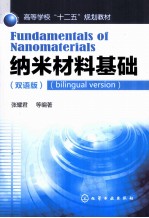图书介绍
纳米材料基础 双语版PDF|Epub|txt|kindle电子书版本网盘下载

- 张耀君等编著 著
- 出版社: 北京:化学工业出版社
- ISBN:9787122101297
- 出版时间:2011
- 标注页数:167页
- 文件大小:56MB
- 文件页数:176页
- 主题词:纳米材料-双语教学-高等学校-教材-汉、英
PDF下载
下载说明
纳米材料基础 双语版PDF格式电子书版下载
下载的文件为RAR压缩包。需要使用解压软件进行解压得到PDF格式图书。建议使用BT下载工具Free Download Manager进行下载,简称FDM(免费,没有广告,支持多平台)。本站资源全部打包为BT种子。所以需要使用专业的BT下载软件进行下载。如BitComet qBittorrent uTorrent等BT下载工具。迅雷目前由于本站不是热门资源。不推荐使用!后期资源热门了。安装了迅雷也可以迅雷进行下载!
(文件页数 要大于 标注页数,上中下等多册电子书除外)
注意:本站所有压缩包均有解压码: 点击下载压缩包解压工具
图书目录
1.Introduction to nanoscale materials1
1.1 Introduction to the nanoworld1
1.2 Definition of nanoscale materials1
1.2.1 Nanometer1
1.2.2 Definition of nanoscale materials2
1.3 Classification of nanoscale materials3
1.3.1 According to the spatial dimension of materials3
1.3.2 According to the quantum properties of materials3
1.3.3 According to material properties5
1.3.4 According to the shape and chemical compositio5
1.4 Nanoscale science and technology9
1.5 Driven by industrial revolution9
1.6 Fundamental limitations of present technology10
1.7 Molecular electronic10
1.8 Technical challenges in future10
1.9 Applications of nanomaterials12
1.9.1 Water purificatio12
1.9.2 Nanocatalysts12
1.9.3 Nanosensors12
1.9.4 Energy13
1.9.5 Medical applications13
References14
Review questions15
Vocabulary15
1.纳米材料概论19
1.1纳米世界概述19
1.2纳米材料的定义20
1.2.1纳米20
1.2.2纳米材料的定义20
1.3纳米材料的分类20
1.3.1依据材料的空间维度分类21
1.3.2依据材料的量子性质分类21
1.3.3依据材料的性能分类22
1.3.4依据形态和化学组成分类22
1.4纳米科学与技术23
1.5工业革命的驱动23
1.6目前技术的基础性缺陷24
1.7分子电子学24
1.8未来的技术挑战24
1.9纳米材料的应用25
1.9.1水的净化25
1.9.2纳米催化剂25
1.9.3纳米传感器25
1.9.4能源25
1.9.5医药中的应用26
复习题26
2.Nanometer effects of nanoscale materials27
2.1 Small size effect27
2.2 Quantum size effect28
2.2.1 Relationship between energy gap and particle size28
2.2.2 Application29
2.3 Surface effect30
2.4 Macroscopic quantum tunnel effect31
2.4.1 Ballistic transport31
2.4.2 Tunneling31
2.4.3 Resonance tunneling32
2.4.4 Inelastic tunneling33
2.4.5 Tunnel effect33
2.4.6 Macroscopic quantum tunnel effect33
References33
Review questions34
Vocabulary34
2.纳米材料的纳米效应35
2.1小尺寸效应35
2.2量子尺寸效应36
2.2.1能隙与粒子尺寸的关系36
2.2.2应用36
2.3表面效应37
2.4宏观量子隧道效应37
2.4.1弹道传输37
2.4.2隧穿38
2.4.3共振隧穿38
2.4.4非弹性隧穿38
2.4.5隧道效应38
2.4.6宏观量子隧道效应38
复习题38
3.Properties of nanoscale materials39
3.1 Mechanical properties39
3.1.1 Positive Hall-Petch slopes39
3.1.2 Negative Hall-Petch slopes39
3.1.3 Positive and negative Hall-Petch slopes40
3.2 Thermal properties41
3.3 Magnetic properties41
3.4 Electronic properties42
3.5 Optical properties44
3.5.1 Photochemical and photophysical processes of nanomaterials44
3.5.2 Absorption and luminescence spectra45
3.5.3 Ultraviolet-visible absorption spectroscopy45
References46
Review questions47
Vocabulary47
3.纳米材料的性能48
3.1力学性能48
3.1.1正的Hall-Petch斜率关系49
3.1.2负的Hall-Petch斜率关系49
3.1.3正-负Hall-Petch斜率关系49
3.2热学性能49
3.3磁学性能50
3.4电学性能50
3.5光学性能51
3.5.1纳米材料的光化学和光物理过程51
3.5.2吸收光谱和发光光谱51
3.5.3紫外-可见吸收光谱52
复习题52
4.Synthesis of nanoscale materials53
4.1 “Top-down” and “bottom-up” approaches53
4.2 Solid phase method54
4.2.1 Mechanically milling54
4.2.2 Solid-state reaction56
4.3 Physical vapor deposition(PVD) method57
4.3.1 Thermal evaporation PVD method57
4.3.2 Plasma-assisted PVD method59
4.3.3 Laser ablation62
4.4 Chemical vapor deposition(CVD) method62
4.5 Liquid phase synthesis method64
4.5.1 Precipitation method64
4.5.2 Solvethermal method66
4.5.3 Freeze-drying method(Cryo-chemical synthesis method)69
4.5.4 Sol-gel method70
4.5.5 Microemulsions method73
4.5.6 Microwave-assisted synthesis76
4.5.7 Ultrasonic wave-assisted synthesis77
4.6 Synthesis of bulk materials by consolidation of nanopowders77
4.6.1 Cold compaction77
4.6.2 Warm compaction78
4.7 Template-assisted self-assembly nanostructured materials78
4.7.1 Principles of self-assembly78
4.7.2 Self-assembly of MCM-4179
4.8 Self-assembly ofnanocrystals80
4.9 Green nanosynthesis81
4.9.1 Prevent wastes81
4.9.2 Atom economy82
4.9.3 Using safer solvent82
4.9.4 Enhance energy efficiency82
References82
Review questions86
Vocabulary86
4.纳米材料制备89
4.1“自上而下”和“自下而上”的合成方法89
4.2固相方法90
4.2.1机械研磨90
4.2.2固相反应91
4.3物理气相沉积法(PVD)91
4.3.1热蒸发PVD法91
4.3.2等离子体辅助PVD法92
4.3.3激光消融法93
4.4化学气相沉积法(CVD)93
4.5液相合成方法94
4.5.1沉淀法94
4.5.2溶剂热法95
4.5.3冷冻干燥法(低温化学合成法)96
4.5.4溶胶-凝胶法97
4.5.5微乳液方法98
4.5.6微波辅助合成99
4.5.7超声波辅助合成100
4.6通过固化纳米粉合成块材100
4.6.1冷压100
4.6.2热压100
4.7模板辅助自组装纳米结构材料101
4.7.1自组装原理101
4.7.2 MCM-41自组装101
4.8自组装纳米晶101
4.9绿色纳米合成102
4.9.1防止废弃物102
4.9.2原子经济102
4.9.3使用更安全的溶剂103
4.9.4提高能源效率103
复习题103
5.Scanning tunneling microscope and atomic force microscope104
5.1 Scanning tunneling microscope(STM)104
5.1.1 Basic principle of STM104
5.1.2 Operation modes105
5.1.3 Application of STM105
5.2 Atomic force microscope(AFM)106
5.2.1 Basic principle of AFM106
5.2.2 Mode of operation of AFM107
5.2.3 Application of AFM108
References109
Review questions110
Vocabulary110
5.扫描隧道显微镜和原子力显微镜111
5.1扫描隧道显微镜(STM)111
5.1.1 STM的基本原理111
5.1.2操作模式111
5.1.3 STM的应用111
5.2原子力显微镜(AFM)112
5.2.1 AFM的基本原理112
5.2.2 AFM的操作模式112
5.2.3 AFM的应用113
复习题113
6.Synthesis of carbon nanomaterials114
6.1 Carbon family114
6.1.1 Graphite and diamond114
6.1.2 Allotrope of carbon114
6.2 Fullerenes115
6.2.1 Synthesis of C60115
6.2.2 Purification of fullerenes117
6.2.3 Structure of C60118
6.2.4 13C nuclear magnetic resonance spectroscopy118
6.2.5 Endofullerenes119
6.2.6 Nucleophilic addition reactions119
6.2.7 Polymerization of C60120
6.2.8 Fabrication of nanocar120
6.3 Carbon nanotubes122
6.3.1 Synthesis of nanotubes122
6.3.2 Growing mechanisms124
6.3.3 Geometry of carbon nanotubes127
References128
Review questions130
Vocabulary131
6.碳纳米材料的合成132
6.1碳族132
6.1.1石墨和金刚石133
6.1.2碳的同素异形体133
6.2富勒烯133
6.2.1 C60的合成133
6.2.2富勒烯的提纯134
6.2.3 C60的结构134
6.2.4 13C核磁共振谱134
6.2.5富勒烯包合物134
6.2.6亲核加成反应135
6.2.7 C60的聚合反应135
6.2.8纳米车的制造135
6.3碳纳米管[45]135
6.3.1碳纳米管的合成135
6.3.2生长机理136
6.3.3碳纳米管的几何构型136
复习题137
7.Lithography for nanofabrication138
7.1 Microfabrication by photolithography of ultraviolet light138
7.2 Nanofabrication by scanning beam lithography141
7.2.1 Electron beam lithography141
7.2.2 Focused ion beam lithography141
7.3 Nanoimprint lithography142
7.3.1 Nanoimprint lithography142
7.3.2 Step-and-flash imprint lithography143
7.3.3 Microcontact printing143
7.4 Scanning probe lithography144
References146
Review questions147
Vocabulary148
7.光刻技术用于纳米制造148
7.1紫外线光刻微制造149
7.2扫描束刻蚀纳米制造150
7.2.1电子束刻蚀150
7.2.2聚焦离子束刻蚀151
7.3纳米压印刻蚀技术151
7.3.1纳米压印刻蚀151
7.3.2步进式闪烁压印光刻151
7.3.3微接触印制152
7.4扫描探针刻蚀152
复习题153
8.Nanotechnology for production of hydrogen by solar energy154
8.1 Conversion of solar energy154
8.2 Hydrogen production by photo- catalytic water splitting154
8.3 Loading metal over TiO2155
8.4 Development of visible-light-driven photocatalysts155
8.4.1 Loading Cr3+over titanate nanotubes156
8.4.2 Semiconductor composition157
References161
Review questions161
Vocabulary162
8.纳米技术用于太阳能制氢162
8.1太阳能转换163
8.2光催化分解水制氢163
8.3 TiO2上负载金属163
8.4可见光驱动的光催化剂的发展163
8.4.1在钛酸盐纳米管上负载Cr3+164
8.4.2半导体复合材料164
复习题165